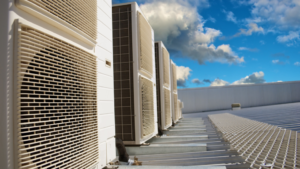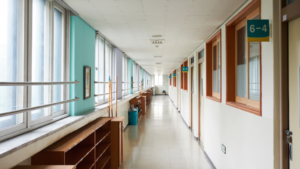
The COVID-19 pandemic has brought forward the importance of optimizing building design and the interior wallpaper design for occupant well-being and places emphasis on the interaction between indoor air quality (IAQ) and human health. The effects of poor IAQ can occur immediately via sick building syndrome (SBS), while other related health effects (respiratory diseases, heart disease) occur years later and may be fatal. Improving the indoor air quality within the built environment is paramount, especially in light of the pandemic, as airborne transmission is a significant pathway for spreading of the virus.
Kindergarten to 12th grade (K-12) schools in North America are very susceptible to poor IAQ conditions, with many public schools maintaining ventilation rates that fall far short of building requirements. The US Government Accountability Office (GAO) identified that about 41% of public school districts needed to update or replace HVAC systems in at least half of their schools, due to outdated systems (with some equipment being close to 100 years old), malfunctioning equipment, or lack of HVAC functions (i.e., no air conditioning available).
In recognition of the difficulties that K-12 schools face with respect to IAQ, especially in light of COVID-19, the John Hopkins Bloomberg School of Public Health’s Center for Health Security recently released School Ventilation: A Vital Tool to Reduce COVID-19 Spread, a report on ventilation in K-12 schools in the United States. The report acknowledged the poor state of ventilation within the public school system, how COVID-19 has impacted students, families, faculty and staff, and the evidence that ventilation reduces disease transmission. The report leveraged the experience of 32 experts within a variety of fields, including air quality, education policy, and engineering, to assist in the production of the report, supply the best in peer-reviewed literature, as well as to make recommendations on ventilation guidelines for schools.
This report is a useful reference guide for school administrators and other faculty to understand:
- Current ventilation guidelines,
- Benefits of improved ventilation within indoor environments, and
- The cost-effectiveness of ventilation improvements relative to other cleaning procedures as recommended by the CDC, such as “deep” cleaning of high-touch surfaces.

This report is well timed given the announcement from the Biden-Harris Administration of fiscal funds being made available for public schools. The American Rescue Plan includes nearly $130 billion for K-12 schools and a further $39 billion for pre-school facilities, with both amounts allocating funding directly towards improving ventilation in educational settings. With ventilation improvements being an extremely cost-effective method of improving IAQ and reducing the transmission of diseases, K-12 schools should take advantage of these public funds to improve, replace, or enhance their ventilation/HVAC systems.
One of the experts leveraged within the report is Autocase’s own Chief Economist, Eric Bill. His 20 year experience in the interactions between building science, economics, and occupant well-being offered a unique perspective on the reliability of ventilation as a cost-effective measure to improve human health. The Autocase economics team is currently working on several school and children betterment projects, including:
- Evergreen Climate Ready Schools in Ontario Canada
- Alief Independent School District in Houston Texas
- Children & Nature Network and UC Denver to study the Learning Landscapes program across Denver Public Schools
- Helen R Walton Children’s Enrichment Center, quantifying outcomes from toxics materials reductions, state-of-the practice IAQ elements and programming concepts.
School owners, facility managers, and families should be encouraged and advocate to leverage recent federal fund allocations to invest in cost-effective ventilation improvements within their buildings.
Autocase can support all stakeholders (financial, social, and environmental) of the school to value the holistic benefits of improved ventilation (including reduced absenteeism from school, improved productivity via test scores, and improved health outcomes) by creating a business case to garner stakeholder support for more sustainable and resilient infrastructure in education facilities that drive occupant well-being.

0 Comments